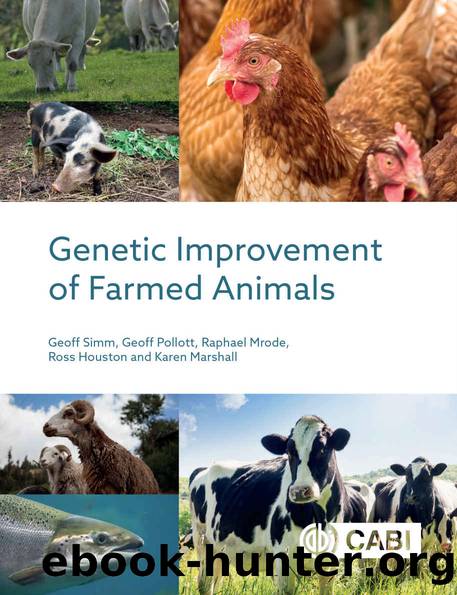Genetic Improvement of Farmed Animals by Geoff Simm & Geoff Pollott & Raphael Mrode & Ross Houston & Karen Marshall

Author:Geoff Simm & Geoff Pollott & Raphael Mrode & Ross Houston & Karen Marshall [Simm, Geoff]
Language: eng
Format: azw3
Publisher: CABI
Published: 2020-11-25T16:00:00+00:00
8 Dairy Cattle Breeding
Introduction
The first seven chapters in this book concentrated on the scientific principles of genetic improvement. The aim of the next six chapters is to give some more details of the current and possible future applications of these principles in practical cattle, sheep, goat, poultry, pig and fish breeding. Chapters 8 to 12 follow a similar format. (Chapter 13 has a slightly modified format because of the wide range of species involved in aquaculture.) They begin by examining breeding goals in a general way, to identify animal characteristics likely to be important in genetic improvement programmes. Next, they examine breeds and crosses in widespread use, and methods of selection within breeds, including systems of testing, traits recorded and methods of genetic evaluation. Finally, each chapter has a section on the evidence for genetic improvement and its value, and a list of practical guidelines on selection. We start with dairy cattle breeding as there is probably more information in the public domain about dairy cattle breeding than about any other farmed species, so this is a good starting point to illustrate the principles of genetic improvement in practice.
Most of the examples of dairy cattle breeding discussed in this chapter are from the UK, elsewhere in Europe, New Zealand, Canada and the USA. However, they are intended to illustrate issues of wide relevance in dairy cattle breeding, at least in temperate areas. To show the context into which production in these countries fits, Fig. 8.1 shows the world production of cow milk by continent in 2016. Europe had the highest production, accounting for about 33% of global milk production. Figure 8.2 shows the amount of milk produced in 2016 by the 15 highest-producing countries in the world. The US was by far the largest producer, but The Russian Federation, India, several European countries, New Zealand and Australia featured in the top 15.
Download
This site does not store any files on its server. We only index and link to content provided by other sites. Please contact the content providers to delete copyright contents if any and email us, we'll remove relevant links or contents immediately.
Sapiens: A Brief History of Humankind by Yuval Noah Harari(14168)
Sapiens by Yuval Noah Harari(5266)
Pale Blue Dot by Carl Sagan(4861)
Homo Deus: A Brief History of Tomorrow by Yuval Noah Harari(4779)
Livewired by David Eagleman(3626)
Origin Story: A Big History of Everything by David Christian(3592)
Brief Answers to the Big Questions by Stephen Hawking(3319)
Inferior by Angela Saini(3211)
Origin Story by David Christian(3119)
The Gene: An Intimate History by Siddhartha Mukherjee(3014)
Signature in the Cell: DNA and the Evidence for Intelligent Design by Stephen C. Meyer(2999)
The Evolution of Beauty by Richard O. Prum(2916)
Aliens by Jim Al-Khalili(2766)
How The Mind Works by Steven Pinker(2697)
A Short History of Nearly Everything by Bryson Bill(2582)
Sex at Dawn: The Prehistoric Origins of Modern Sexuality by Ryan Christopher(2442)
From Bacteria to Bach and Back by Daniel C. Dennett(2425)
Endless Forms Most Beautiful by Sean B. Carroll(2403)
Who We Are and How We Got Here by David Reich(2376)
